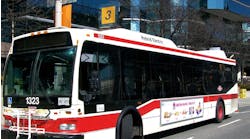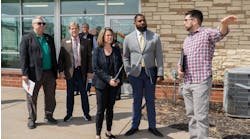CLEVELAND, Ohio — For the second year in a row, the Greater Cleveland Regional Transit has won a major planning grant from the Federal Transit Administration to expand its budding regional bus rapid transit network.
RTA said Wednesday it received news of the grant award on Tuesday. To its surprise, the agency received the full $700,000 amount of its request, or $140,000 more than it expected to receive.
The grant will pay for a project to plan a new bus rapid transit line on Lorain Road, extending 15.7 miles from North Olmsted through neighboring Fairview Park to Ohio City on Cleveland’s West Side.
“We’re pretty excited,’’ said Mike Schipper, RTA’s deputy general manager. He said the agency was pleased to win the new grant a year after having won $432,000 from the federal agency to plan another bus rapid transit route on Broadway from near downtown Cleveland through Slavic Village to Garfield Heights.
“We were a little surprised because we won last year and maybe it wasn’t our turn to win again,’’ Schipper said. “Not only did they award us the grant, they also awarded the entire $700,000. That was probably even more shocking.’’
The grant elevates an emerging regional vision for rebuilding thinly developed portions of Cleveland and its suburbs with dense, walkable development that would work hand in hand with more robust transit service.
“It seems like all the stars are aligning,’’ said Mary Cierebiej, executive director of the Cuyahoga County Planning Commission.
The Federal Transit Administration also awarded $1.2 million to the Central Ohio Transit Authority, serving Columbus, to plan for transit-oriented development along the proposed 9.3-mile West Broad Street bus rapid transit corridor extending from Columbus to Franklin and Prairie townships.
“The [ Columbus] corridor would be the region’s first rapid transit route and serve as the main transit thoroughfare providing connections to north-south routes,’’ the FTA said on its website.
City planners see bus rapid transit, or BRT, as a cheaper alternative to building new streetcar or light rail lines. In a BRT system, buses have special lanes for high-speed boarding, and priority at traffic signals.
The network now shaping up in Cleveland includes the $200 million four-mile Euclid Avenue HealthLine, completed in 2008 from Public Square to University Circle, and the simpler and less costly Cleveland State University line completed in 2014.
The CSU line includes a four-mile corridor on Clifton Boulevard on Cleveland’s West Side that consolidates routes for No. 55 buses running from Rocky River and Lakewood to CSU’s downtown campus.
RTA will soon kick off plans for another BRT route on West 25th Street, plus the Broadway line. The agency has raised $30 million toward the estimated $50 million cost of the project, including $12 million from the Ohio Department of Transportation and a $10 million local match.
Schipper said RTA would be in a position to hire a consultant to carry out the planning for the Lorain Road BRT within nine to 12 months. RTA’s grant application envisions building the line starting in 2030 and beginning service in 2032.
The agency’s application said the planning project will “analyze specific sites with the potential to increase the supply of affordable housing,’’ and that it “will review the housing market to identify gaps, such as senior, inter-generational, low/moderate income.”
Schipper said that cooperation among officials from Cleveland, Cuyahoga County, Fairview Park and North Olmsted may have helped to convince the feds to award the latest grant. RTA also said that winning a planning grant improves the agency’s chances of winning far bigger construction grants from the federal government in the future.
Schipper said that shifts in political leadership, including control of the presidency and Congress, have not affected the federal government’s willingness to fund a transit-planning grant once it has been awarded.
“We’ve gone through various changes at the federal level, and no administration change has impacted a grant that we’ve been awarded,’' Schipper said.
Cuyahoga County has been planning in sync with RTA’s vision for the future. The county’s planning commission is weeks away from releasing a model zoning code for suburbs of Cleveland showing how they could rezone 85 square miles of thinly developed land along 22 corridors in Cleveland and 25 suburbs with dense, walkable “transit-oriented development.”
The county is largely built out. One way for it to grow and build its tax base and population is to make better use of land with spread-out development designed around automobiles. Transit-oriented development can help.
North Olmsted is receptive to the idea. It recently completed a study showing how parking lots around the partially vacant Great Northern Mall could be redeveloped with housing located near the proposed bus rapid transit route on Lorain Road.
Max Upton, North Olmsted’s director of economic and community development, said he was thrilled to hear about the new RTA grant.
“It’s wild,’’ he said. “We’re super excited about the possibilities it could unlock for North Olmsted and for the region.’’
©2024 Advance Local Media LLC. Visit cleveland.com. Distributed by Tribune Content Agency, LLC.



